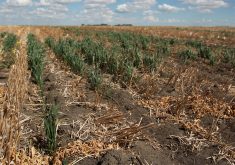Alberta Premier Danielle Smith says there will be public engagement on how to best manage provincial water supplies as the situation threatens to become worse if moisture levels in southern Alberta don’t improve.
“My environment minister (Rebecca Shultz), who is responsible for water, is looking into this (and) is going to be engaging with the public about how we should be addressing these issues,” said Smith during a media availability in Medicine Hat.
The premier said improving irrigation infrastructure, especially to be able to capture more mountain snowpack runoff, is a long-term solution to the issue.
Read Also

Short rapeseed crop may put China in a bind
Industry thinks China’s rapeseed crop is way smaller than the official government estimate. The country’s canola imports will also be down, so there will be a lot of unmet demand.
“And we’ll have to be continuing to work with the scientists to see whether or not this is a short-term, mid-term or long-term problem,” she said.
Southern Alberta is particularly hard hit, but there are currently 44 water shortage advisories in place stretching from Hay River in the north to the Milk River on the U.S. border.
“The barrel is dry,” said Tim Romanow, executive director of the Milk River Watershed Council, referring to the St. Mary Reservoir, which was drained this year.
However, there are scenarios that can play out in the next few months to dramatically alter the situation along the St. Mary and Milk river basins, which are governed by an international water treaty with the United States.
“If we have an exceptional snowpack this year and some major precipitation events in the next few weeks before things freeze up completely, it’s entirely possible (levels) can come up a little bit and put us in a slightly better position,” he said.
“But it’s going to take an exceptional snowpack to get us near anywhere near average.”
Alberta advanced its water shortage management system to Stage 4 — one stage shy of an emergency declaration — on July 21, where it remains.
Contact alex.mccuaig@producer.com
















